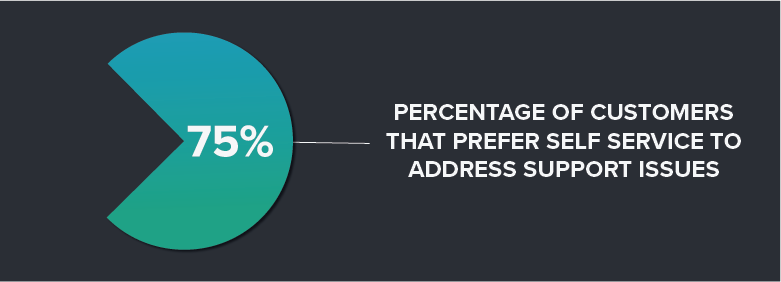
Welcome to part three of our Digital Transformation for Customer Support series! If you missed any of our other installments, check them out here: Driving Digital Channel Adoption, Optimizing Internal Knowledge Operations, and Shifting from Reactive to Proactive Support.
What does it take to offer amazing customer service experiences?
Today’s customers have higher expectations for every aspect of support and service – and it seems like the standards are always rising.
One of the easiest ways to provide convenient, efficient support is by making it possible for your customers to help themselves. That is, by adopting self-service customer support as a central pillar of your overall support strategy.
Self-service resources can include everything from FAQs to chatbots to video tutorials to an in-depth knowledge base. Offering a selection of accessible self-service support options empowers customers to find answers and resolve common support issues on their own.

Done, well, self-service support benefits your business, your support agents, and your customers.

A poorly executed self-service strategy is arguably worse than not offering self-service options at all. Why? Because by the time the customer decides to give up and contact a support agent, they’re already frustrated from trying to navigate badly-designed self-service resources.
So, if your self-service resources are incomplete, hard to find, or hard to navigate, then your agents, customers, and entire support strategy will suffer as a result. That’s why it’s critical to get self-support right from the very start – which means you need a solid self-service strategy that serves both your customers and your business.
Follow these steps to create a self-service support strategy that aligns with your existing support framework and organizational goals.
Start by figuring out what you want to achieve. Once your self-service resources are up and running, what will be your primary goal or metric by which you’ll measure your success? If you can define a central purpose for the strategy shift – for instance, cutting backlog by 25% – it’s a lot easier to get your whole organization onboard with the change.
To help you decide what metric or objective to base your strategy on, consider where your current support operations need the most improvement. You should ask your support agents for input on what they find most frustrating or what their greatest challenges are.
Whatever targets you choose to focus on, make sure you track your progress before and after implementation of your self-service strategy.
Next, you need to create an action plan for bringing your self-service resources to life, along with a schedule for when each resource will be completed. When planning out your first steps, involve your agents to find out which topics and questions come up most frequently. This will give you a clear starting point and focus on how to build out your support resources.
When determining what type of self-service support you should provide, look to your customers for inspiration. Where are they currently looking for answers? What type of resource makes the most sense for the types of question they tend to ask most often? The most popular options for self-service support include FAQs, a public knowledge base, interactive voice recognition, and chatbots.
Your self-service options are only effective if your customers use them. This means making sure customers know your self-service resources exist, can easily access them whenever necessary, and ensuring that the resources provide complete resolutions (so customers don’t end up contacting support anyway).
Here are some tips for designing self-service offerings that your customers are willing and happy to use.
As with making any type of change to your support operations, one of the keys to getting self-service right is to think about it within the context of the entire customer journey. Whatever self-service resources you choose to create, they must be designed with your customers in mind.
So, listen to what your customers are saying. What are their most common questions? What are the most confusing aspects of your product or service? Which support issues tend to take the longest to resolve over the phone or live chat – and how can these experiences be improved or sped up with self-service support?
The more relevant your self-service options are to your target customers, the more likely they are to actually use them. A study by Coleman Parkes for Amdocs found that 91% of customers would use an online knowledge base if it were available and designed to meet their specific needs.

This might seem obvious, but it’s too important to skip over completely. You need to tell your customers about your new self-service resources. Otherwise, they’re unlikely to stumble across them.
For instance, when an agent resolves a support issue, they can end the interaction by referring the customer to a relevant knowledge base article for future reference. You should also include links to self-service resources in email responses and live chat conversations in case the customer wants to learn more about a particular issue.
Not only should your resources be easy to access on your website, but they should also be easy to navigate. Your customers should be able to view them on any device, so if your website still isn’t mobile-friendly, now is the perfect time to upgrade.
Additionally, it’s a good idea to include visual aids, like videos, screenshots, and graphics, to help customers understand the solution or next steps. Make use of descriptive titles, subheadings, and bullet points to ensure the content skimmable and easy to digest.

One of the main benefits of self-service support is that it reduces the burden placed on your agents – but that doesn’t mean you should make it more challenging for your customers to reach out for live support.
In fact, you should do everything possible to reassure your customers that live help is still available if they need it. Include your support email and phone number at the bottom of your FAQ page, have a chatbot standing by to connect customers to support agents via live chat, and work to improve your team’s efficiency to keep wait times short.
Instead of making it harder to connect with agents in an attempt to promote self-service resources, focus on making your support resources so amazing that customers won’t want or need to speak to your support team.
In the face of a support issue, an already frustrated customer doesn’t want to spend ages sifting through vague or incomplete self-service resources. It should be easy to find what they need, the information should always be accurate, and the resources should provide a complete solution.
According to a survey by Software Advice, 31% of customers get frustrated if it takes them even five minutes to find what they’re looking for. Another 11% find it ‘very frustrating’ and 10% find it ‘extremely frustrating.’

It doesn’t matter how much information your knowledge base includes about a specific topic if your customers can’t find it quickly and understand it clearly. If you find that you’re getting the same amount of calls and requests as before you implemented self-service, you may need to revisit your self-service strategy to see how it can be optimized. That means keep your content up-to-date, rewriting knowledge base articles when necessary, and taking customer feedback into account.
In order to work as a long-term strategy, your self-service options should integrate with the rest of your support operations. For example, if a customer gives their order number to a self-service chatbot to look up the shipment date, then your human team members should have access to that same information if they need to step in to take over for the bot. Regardless of what type of self-service support you offer, omnichannel support can take your customer support experiences to the next level.
The key to effective self-service resources – and to better customer experiences overall – is to think holistically about revamping your support strategy. If you’d like to learn more about creating exceptional customer experiences, sign up to get monthly updates and tips from our blog delivered right to your inbox.
Continue reading the Digital Transformation series: Part 4: Shifting from Reactive to Proactive Support